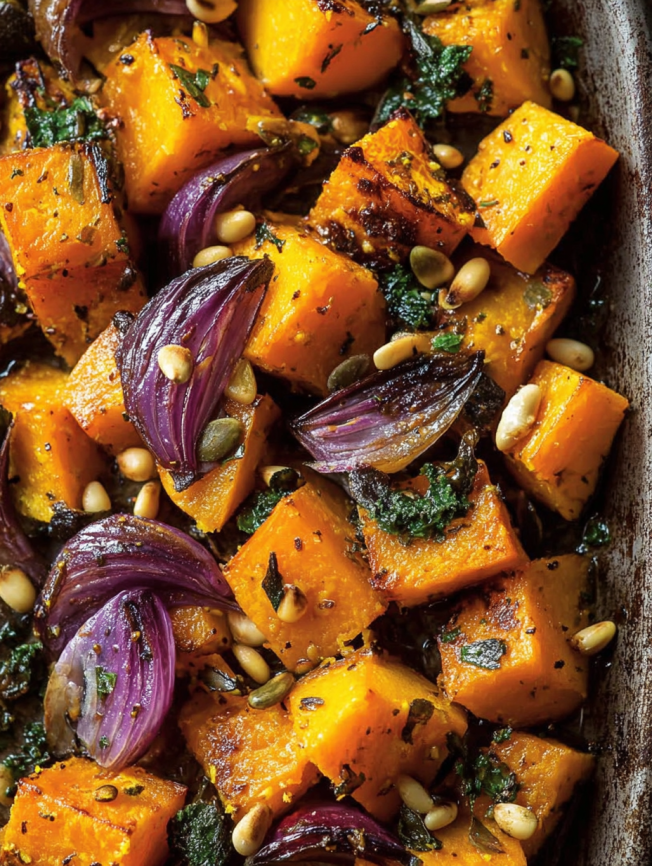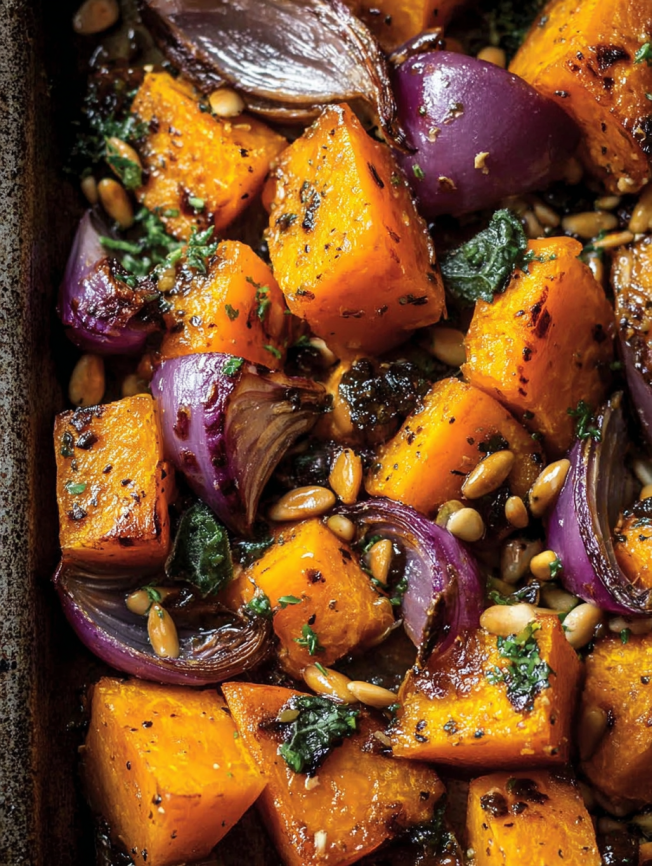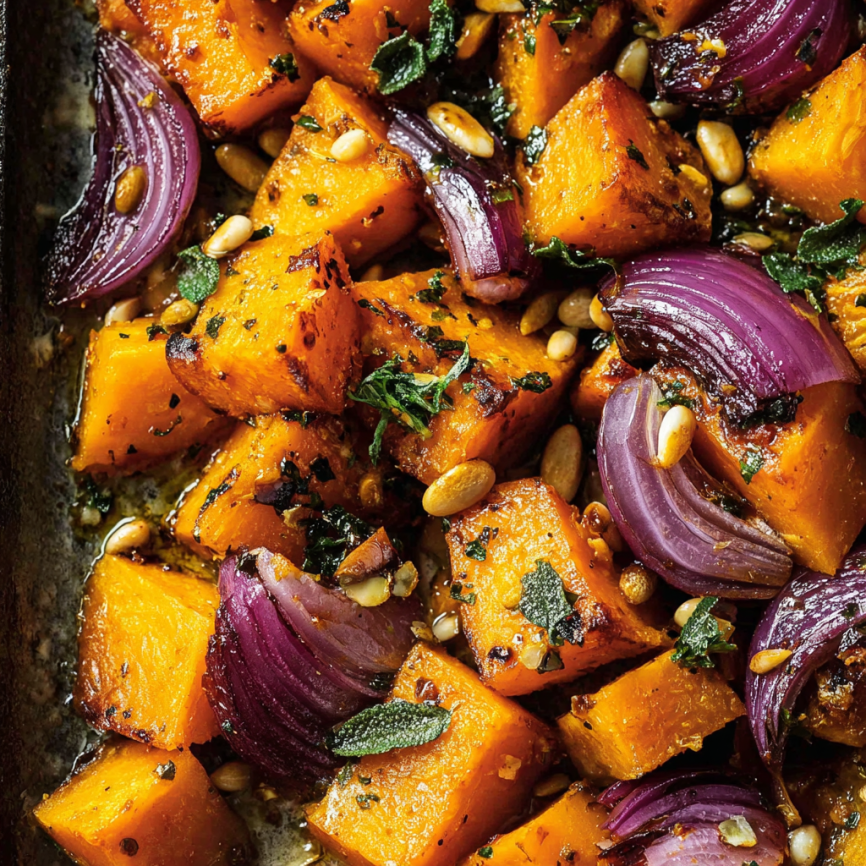Last autumn, I found myself staring at a beautiful butternut squash from the farmer’s market, wondering how to transform it into something truly special. Having recently fallen in love with Middle Eastern flavors during a cooking class, I decided to experiment with tahini – that creamy, nutty sesame seed paste I’d been adding to everything. What emerged from my oven that evening was pure magic: caramelized butternut squash and sweet red onions crowned with a silky tahini drizzle and aromatic za’atar.
The combination was revelatory. Furthermore, the natural sweetness of the roasted vegetables paired beautifully with the tangy, creamy tahini sauce, while the za’atar added an exotic warmth that made every bite feel like a celebration. This dish has since become my go-to recipe when I want to impress guests or simply treat myself to something both nourishing and indulgent.
Why You’ll Fall in Love with This Recipe
A Symphony of Flavors and Textures
This dish masterfully balances sweet, savory, creamy, and tangy elements in every forkful. The butternut squash develops a caramelized exterior while maintaining a tender, almost custard-like interior. Meanwhile, the red onions transform from sharp and pungent to mellow and sweet, creating a harmonious contrast that’s both satisfying and sophisticated.
Effortless Elegance
Despite its impressive appearance, this recipe requires minimal hands-on time and uses simple, wholesome ingredients. Additionally, most of the work happens in the oven while you attend to other tasks, making it perfect for both weeknight dinners and special occasions when you want maximum impact with minimal stress.
Nutritional Powerhouse
This plant-based dish delivers exceptional nutritional value without compromising on flavor. Rich in beta-carotene, fiber, healthy fats from tahini, and antioxidants, it nourishes your body while delighting your taste buds. Moreover, it’s naturally gluten-free, dairy-free, and vegan, accommodating various dietary preferences effortlessly.
Seasonal Celebration
This recipe perfectly captures the essence of autumn cooking, showcasing seasonal produce at its absolute best. Furthermore, it connects you to the rhythms of nature while providing comfort during cooler months, making it an ideal addition to your fall repertoire.
Ingredients You’ll Need
For the Roasted Vegetables:
- 1 large butternut squash, peeled and cut into wedges
- 2 red onions, cut into thick wedges
- 3 tablespoons extra virgin olive oil
- 1/2 teaspoon ground cinnamon
- Sea salt and cracked black pepper, to taste
For the Tahini Dressing:
- 3 tablespoons tahini (well-stirred)
- 1 tablespoon fresh lemon juice
- 1 small garlic clove, minced
- 2 tablespoons warm water (adjust as needed)
For the Finishing Touches:
- 1 tablespoon fresh parsley, chopped
- 1 tablespoon toasted pine nuts
- 1 tablespoon za’atar spice blend
Serving Suggestions:
Consider serving this versatile dish over quinoa or farro for a complete meal, alongside grilled proteins, or as part of a Mediterranean mezze spread with hummus and warm pita bread.
Step-by-Step Instructions
Preparing for Roasting
Begin by preheating your oven to 425°F (220°C), ensuring it reaches the proper temperature for optimal caramelization. Next, prepare your vegetables by peeling the butternut squash and cutting it into uniform wedges, approximately 1-inch thick. Similarly, cut the red onions into thick wedges, keeping the root end intact to help them hold together during roasting.
Seasoning and Arrangement
Place the butternut squash and red onion wedges on a large, rimmed baking sheet, ensuring they have adequate space for even browning. Drizzle the vegetables generously with olive oil, then sprinkle with ground cinnamon, sea salt, and freshly cracked black pepper. Using clean hands, toss everything together until the vegetables are evenly coated with the oil and seasonings.
The Roasting Process
Transfer the baking sheet to the preheated oven and roast for 30-35 minutes, turning the vegetables halfway through the cooking time. This ensures even caramelization on all surfaces. The vegetables are ready when they’re fork-tender and beautifully golden with caramelized edges that speak to their concentrated sweetness.
Creating the Tahini Dressing
While the vegetables roast, prepare your tahini dressing by whisking together tahini, fresh lemon juice, minced garlic, and warm water in a small bowl. Start with the specified amount of water, then adjust gradually until you achieve a smooth, pourable consistency. The dressing should coat the back of a spoon but still drizzle easily.
Final Assembly
Once the vegetables are perfectly roasted, arrange them artfully on a serving platter, alternating colors for visual appeal. Drizzle the tahini sauce generously over the warm vegetables, allowing it to pool slightly in the crevices. Finally, sprinkle with chopped fresh parsley, toasted pine nuts, and za’atar for a beautiful finish that adds both flavor and visual interest.

Serving Suggestions
As a Stunning Main Course
Transform this dish into a complete meal by serving it over a bed of fluffy quinoa, pearl couscous, or wild rice. Add a handful of chickpeas or white beans for extra protein, creating a satisfying and nutritionally complete plant-based dinner that will leave you thoroughly satisfied.
Mediterranean Mezze Style
Present this dish as part of a larger Mediterranean spread alongside hummus, baba ganoush, warm pita bread, olives, and fresh vegetables. This approach allows guests to create their own combinations while enjoying the convivial atmosphere of shared dining.
Elegant Side Dish
Pair this roasted vegetable medley with grilled lamb, roasted chicken, or seared fish for an elegant dinner party menu. The sweet and savory flavors complement protein dishes beautifully while adding color and sophistication to your table presentation.
Warm Salad Base
Allow the roasted vegetables to cool slightly, then toss with fresh arugula or baby spinach, crumbled feta cheese, and additional lemon juice for a hearty warm salad that bridges the gap between seasons.
Recipe Variations
Spice Blend Alternatives
While za’atar is traditional and highly recommended, you can experiment with other Middle Eastern spice blends. Dukkah, with its mixture of nuts, seeds, and spices, provides wonderful texture and flavor. Alternatively, sumac alone adds a beautiful tartness and stunning color contrast.
Additional Vegetables
Expand this recipe by including other autumn vegetables such as delicata squash, sweet potatoes, or parsnips. Brussels sprouts, when halved and roasted alongside, add a pleasant bitterness that balances the dish’s natural sweetness beautifully.
Protein Additions
For a more substantial meal, consider adding chickpeas during the last 15 minutes of roasting, or top the finished dish with crumbled goat cheese, feta, or toasted pumpkin seeds for extra richness and texture.
Sauce Variations
Experiment with different tahini-based sauces by adding honey for sweetness, harissa for heat, or fresh herbs like cilantro or mint for brightness. Each variation creates a completely different flavor profile while maintaining the dish’s core appeal.
Make-Ahead Tips
Advance Preparation
The vegetables can be cut and stored in the refrigerator up to 24 hours before roasting, making this dish perfect for entertaining. Simply toss with oil and seasonings just before placing in the oven to maintain optimal texture and prevent oxidation.
Component Preparation
The tahini dressing can be prepared up to three days in advance and stored in the refrigerator. Before serving, let it come to room temperature and whisk in a little warm water if it has thickened, ensuring the perfect drizzling consistency.
Reheating Guidelines
Leftover roasted vegetables reheat beautifully in a 350°F oven for 10-15 minutes until warmed through. Alternatively, they’re delicious served at room temperature, making them perfect for lunch bowls or quick meals throughout the week.
Storage Solutions
Store leftover components separately in the refrigerator for up to four days. Keep the roasted vegetables in one container and the tahini dressing in another, combining them just before serving to maintain optimal texture and freshness.
Important Notes
Squash Selection: Choose butternut squash that feels heavy for its size with unblemished skin. The neck portion (where the seeds aren’t located) is easiest to work with and provides the most usable flesh for this recipe.
Tahini Quality: Use high-quality tahini for the best flavor and texture. Well-stirred tahini should be smooth and pourable, not thick or separated. If your tahini seems thick, mix it thoroughly before measuring.
Pine Nut Toasting: Toast pine nuts in a dry skillet over medium heat for 2-3 minutes, stirring frequently, until golden brown. Watch carefully as they can burn quickly, but properly toasted nuts add incredible flavor and crunch.
Za’atar Freshness: Fresh za’atar makes a significant difference in this dish. Look for it in Middle Eastern markets or specialty spice shops, where it’s likely to be more fragrant than supermarket versions.

Frequently Asked Questions
Q: Can I prepare this dish without tahini? A: While tahini is central to this recipe’s character, you can substitute it with a mixture of Greek yogurt and lemon juice for creaminess, or simply drizzle with good olive oil and a squeeze of lemon. However, the nutty richness of tahini truly elevates the dish and is worth seeking out.
Q: How do I prevent the vegetables from becoming mushy? A: Cut vegetables into uniform pieces to ensure even cooking, and avoid overcrowding the baking sheet, which can cause steaming instead of roasting. Additionally, make sure your oven is fully preheated before adding the vegetables, and resist the urge to stir too frequently during cooking.
Q: Can I make this dish ahead for a dinner party? A: Absolutely! This dish is actually excellent at room temperature, making it perfect for entertaining. Roast the vegetables earlier in the day, then add the tahini dressing and garnishes just before serving. The flavors often improve as they meld together.
Q: What can I substitute for za’atar if I can’t find it? A: While za’atar is unique, you can create a simple substitute by mixing dried thyme, toasted sesame seeds, and a pinch of sumac or lemon zest. Alternatively, everything bagel seasoning provides a different but delicious flavor profile that works surprisingly well.
Q: Is this recipe suitable for meal prep? A: Yes! The roasted vegetables keep well in the refrigerator for up to four days and can be enjoyed cold, at room temperature, or gently reheated. Store the tahini dressing separately and add it just before eating to maintain the best texture and presentation.
Q: Can I use frozen butternut squash for this recipe? A: Fresh butternut squash is preferred for optimal texture and caramelization, but frozen can work in a pinch. Thaw it completely and pat dry before roasting, and expect a slightly softer texture. You may need to reduce the cooking time by 5-10 minutes to prevent overcooking.
Prep Time: 10 minutes | Cooking Time: 35 minutes | Total Time: 45 minutes
Calories: 280 kcal per serving | Servings: 4 generous portions
This Roasted Butternut Squash with Red Onion and Tahini represents the very best of seasonal cooking – simple ingredients transformed into something extraordinary through thoughtful preparation and inspired flavor combinations. Whether you’re embracing plant-based eating, entertaining guests, or simply celebrating the bounty of autumn, this dish delivers on every level. The harmony of sweet caramelized vegetables with creamy, tangy tahini and aromatic spices creates a memorable dining experience that will have you returning to this recipe again and again throughout the fall season and beyond.

